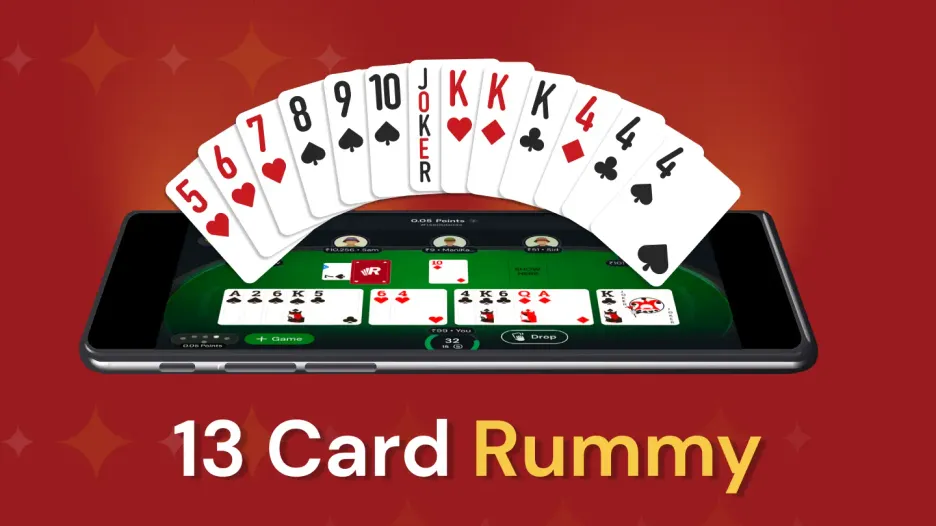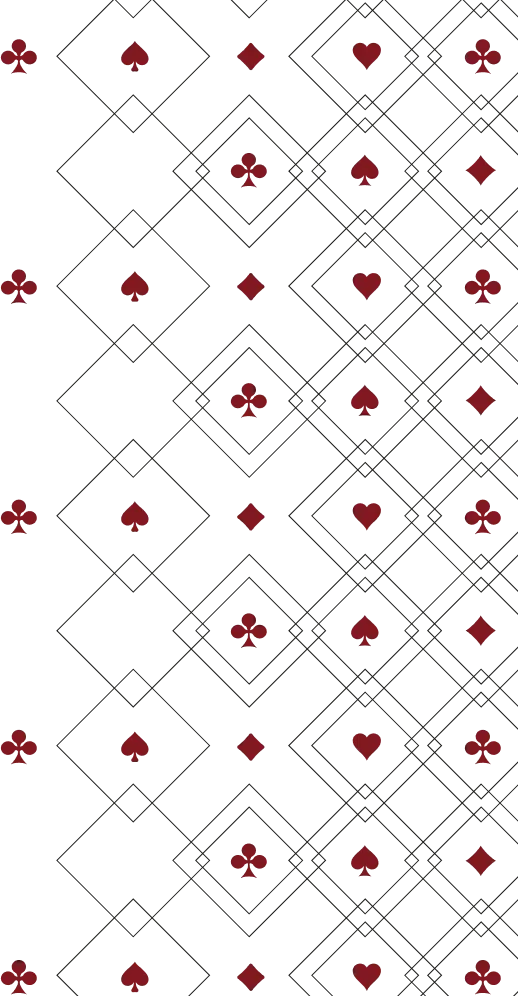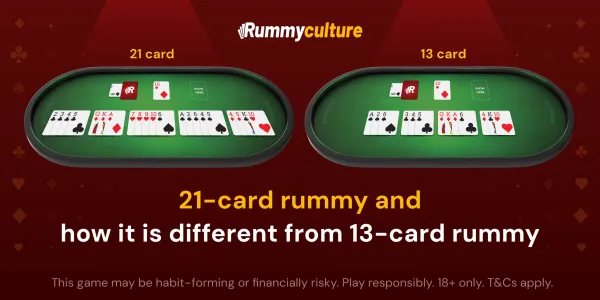13 card rummy
13 Card Rummy or Indian Rummy is one of the most popular played card games in India. This game has deep cultural roots from the Mughal era and has remained a household favorite for generations. A traditional favorite during festivals of lights like Diwali and Holi, 13 Card Rummy is much more than a passing the other time - it’s a game of skill, strategy, and quick thinking that unites your family and friends.
With the advent of technology, the game has moved from the living room to the digital screen. Now, the growing online 13 Card Rummy has made it so easy and convenient for players to play the game anytime and with anyone, escalating the fun and excitement! Free rummy platforms have furthered increased the game's reach, allowing players from novices to seasoned rummy experts to play for free without incurring financial risks while developing their skill over the game.

13 Card Rummy
13 card rummy is played between 2 to 6 players, and each player is dealt 13 cards. Mainly two decks of 52 cards each are used. The objective of the game is to be the first player to make a valid declaration by grouping 13 cards into sequences and sets. A valid declaration must have at least two sequences, one of which has to be a pure sequence. You can group the rest of the cards into sets or sequences.
Popularity of 13 card rummy
13 card rummy is the most popular format of Indian rummy. It's quick, fun, and quite easy to grasp–which explains why it has a very wide player base.
Easy to learn and play
With a very simple objective, rummy is one of the easiest card games to master. Once players understand the logic behind grouping the cards correctly in a game of rummy, they can quickly learn rummy with a few practice games.
Skill based game
Knowing rummy rules is half the battle! The other half, though, is knowing how to quickly change strategies. While the basics remain the same, each rummy game and each hand possesses a different kind of challenge. A player should be able to analyze their hand and decide which cards to keep or discard to maximize their probability of winning.
Fun-Filled and exciting
Indian Rummy is a fun and thrilling opportunity to show your analytical skills, along with the prospect of making some real money with real cash rummy games.
Options for online gaming
With multiple options to play rummy online, 13 card rummy has become more popular and accessible to people everywhere. As more and more people have started using smartphones, playing online games on a rummy app has become a preferred option for many.
Objective of 13 card rummy
A 13 card rummy game has 2 to 6 players, and 13 cards are dealt to each of them. The objective of the game is to divide these 13 cards into melds or groupings. These melds must include: at least 2 sequences, one of which has to be a pure sequence. The rest of the cards can be melded into sequences or sets.
Once a player has these melds in place, they have to make a declaration. A valid declaration means all the conditions are met: you have at least 1 pure sequence, at least 1 other sequence (either pure or impure), and all the cards are part of some sequence or a set. Make a declaration once you discard the 14th card (the last ungrouped card). Once a valid declaration is made by a player, all the other players are prompted to make the best melds possible with their cards and declare.
13 Card rummy rules
13 card rummy is different from its predecessors in terms of the number of cards dealt and a few rules. For instance, in the original version of rummy, 10 cards are dealt to each player whereas in Indian Rummy a hand has 13 cards. In formats like gin rummy, only 2 players participate and ace is the lowest-ranking card in a suit. In the 13 card version of Indian Rummy, 2 to 6 players participate and an ace is considered the highest-ranking card, with the same points as the other face cards (king, queen, and jack).
Sequence
A sequence (or a ‘run’) is a group of at least 3 consecutive cards of the same suit. A Joker card can also be used to complete a sequence, in which case it will be an impure sequence. However, if a wildcard Joker fits naturally into a sequence, you can form a pure sequence with it. For example, if 6 is the wildcard Joker, and you form 5♥️ 6♥️ 7♥️ as a sequence, it will be considered a pure sequence.
Valid pure sequence:
or
Valid impure sequence:
or
Sets
A set is a group of 3 or more cards of the same rank but different suits. A Joker card can also be used to complete a set. You can create a set of up to 4 cards if you don’t use a Joker and up to 7 cards if you are using Jokers. The following are examples of valid sets:
or
or
or
Note: 2 same-ranked cards of the same suit CANNOT be part of the same set.
Valid
Invalid
Printed joker and wild card jokers
In addition to the 2 printed Jokers in the deck, one card is selected out of the closed deck, called the wild card Joker. This wild card Joker lies face up under the closed deck so that all players can see it. This card determines an additional set of Jokers valid for that particular deal. So, any card of the same rank, regardless of the suit, can be used as a wild card Joker.
If the selected card turns out to be a printed Joker, all ace cards become the wild card Jokers for that particular rummy game.
Valid uses of Joker/wild card Jokers:
or
or
How to play 13 card rummy
It is quite simple to master 13 card rummy once a player is aware of the rummy rules and strategies. A player must always focus on creating a pure sequence first before making other melds, and also discard high-value cards to reduce the number of points. By keeping this in mind, one just needs a few practice games to learn it completely.
Shuffle and dealing of cards
In 13 card rummy, depending on the number of players, one or two decks of cards will be used in the game. Cards are shuffled thoroughly to ensure the deck is as random as possible. When playing rummy online, apps like RummyCulture incorporate a system called the Random Number Generator (or RNG) that ensures a fair, random distribution of cards. The act of distribution of cards is called dealing.
Open card
Once 13 cards are dealt to all the players, one card is put face up in the middle of the table. This is the open card. The player who goes first can either choose to pick this card, or take one from the closed deck.
Declaration of wild card joker
One card is randomly picked from the closed deck, which becomes the wild card Joker. This card is placed face up under the closed deck, so all players know which cards can be used as wild card Jokers. All cards of the same rank as the picked card, irrespective of their suits, would qualify as wild card Jokers.
Drawing and discarding of cards
Once all cards are dealt, an open card is placed and a wild card Joker has been established, the game starts with the first player either drawing one card from the open or the closed deck. After drawing a card and sorting their hand, the first player discards a card that is of no use to them. This card goes to the open or discard pile. The game continues and the second player can either pick the first player’s discarded card or draw a new one from the closed deck, and so on until all players have taken a turn.
If the open card is a Joker or wild card Joker, the first player has the opportunity to take it, but discarded Joker cards can not be picked up by other players.
Declare
The turns continue until one player has a valid declaration–with at least 2 sequences (one of them compulsorily has to be a pure sequence). Once all cards have been melded into sequences and sets, the 14th card is discarded to make a declaration.
As soon as a valid declaration is made, all the other players on the table are prompted to sort their cards and declare their best possible grouping.
13 card rummy variations
Rummy is a widely played card game that has various rummy variations. One of the most popular forms of the game is 13 card rummy. Read on to discover the different types of 13 card rummy
Deals rummy
In this variant of 13 card rummy, the number of deals is fixed before the start of the game. Each player gets a certain number of chips. The winner of a deal collects chips based on the score of other players. The player who has the highest number of chips after completing the fixed number of deals wins the game.
Pool rummy
Pool rummy has 3 formats - Pool 61, Pool 101, and Pool 201.
The main objective of the Pool rummy game is to not exceed a fixed score, and this score is based on the format of the game. The winner is the last player remaining after all other players have exceeded the score limit (61, 101, 201).
Points rummy
It’s the quickest variant of Indian Rummy. The concept of this format is simple - players in the game need to make a valid declaration to win the game. The winner is the player who declares the cards first. Points rummy is also known as 13 card points rummy, emphasizing its fast-paced nature and simplicity.
Calculation of points in 13 card rummy
The player who makes a valid declaration first is declared the winner. They would be said to have 0 points.
Points are calculated as the sum total of the ungrouped cards in a hand. For example, after a valid declaration is made, another player has the following cards:
Here, the player has a pure sequence, an impure sequence, a set, and three ungrouped cards-
The valid melds would be equal to 0 points, while the ungrouped cards would be equal to 4 + 8 + 9 = 21 points.
The points for each numbered card is equal to the number printed on it, while face cards (king, queen, and jack) and ace equal 10 points each. A Joker (both printed and wild cards) is equal to 0 points.
The objective of 13 card rummy is to make a valid declaration or leave the least amount of points possible.
Winning calculations in 13 card points rummy
In order to understand Indian Rummy more thoroughly, every player needs to be well versed in the calculations for each variant. Here’s how the winnings are calculated:
For points rummy:
In 13 card rummy, there’s always a pre-decided rupee value for each point as players join the game. And, at the end of the game, the winner of the game gets the entire amount lost by the other players. For example:
If 6 players are playing on a table with a point value of 1, then each point is worth ₹1. Let’s assume that the total score of ungrouped cards of the losing players is 107, then the winner gets ₹107 minus the platform charge.
For pool rummy:
In 13 card rummy, Pool rummy players are required to join a table with a fixed Buy-In. And, based on the number of players, the prize pool is formed. For example, if 6 players join a Pool Rummy with a ₹10 Buy-In, the prize pool of the game would be ₹60. The winner will take the entire prize pool of ₹60 minus the platform charge.
For deals rummy:
Similar to Pool rummy, Deals rummy also has a pre-decided Buy-In amount. For example, if 6 players join a Deals Rummy game with a ₹10 Buy-In, the prize pool would be ₹60. The winner takes the entire prize pool of ₹60 minus the platform charge.
Deal-wise calculation:
In this variant of Indian Rummy, there is a fixed number of deals, and the winner of each deal gets chips from the losing players. Here’s how the calculation works:
- At the start, every player receives a fixed number of chips.
- After each deal, the losing players’ scores are calculated based on their ungrouped cards.
- The winner of the deal gets chips equivalent to the total points lost by the other players.
- For example, if 4 players are playing a Deals rummy game, and the losing players have scores of 20, 30, and 50 respectively, the winner receives 100 chips (20+30+50).
- At the end of all deals, the player with the highest number of chips is declared the overall winner.
13 card Rummy FAQs
How do you play 13 card rummy?
13 Card Rummy is one of the most played skill game played with cards where 13 cards are dealt to all the players. The goal is to create valid sets and sequences with these cards. At least one pure sequence (sequence without Joker) and rest sequences or sets. On their turns, players draft/discard from the open or closed deck to complete their hands. After the first round of play, the game concludes when a player declares a valid hand and scores points for unmatched cards.
What are the rules for 13 cards?
13 Card Rummy Important Rules 13 Card Rummy — 13 Card Rummy is a popular variant of the rummy game.
1. All players are dealt 13 cards.
2. The point is to create valid sequences and sets.
3. One pure sequence is required for a valid declaration.
4. Players draw and discard cards until their hands are complete.
5. A Joker (Either Wild or printed Joker) can be used as a Substitute for missing cards in sets and sequences (excluding pure sequences).
6. The game ends when a player makes a valid declaration, and points are counted for opponents based on cards that have no groups.
How are 13 cards divided?
In 13 Card Rummy, each player receives 13 cards from a standard 52-card deck (with or without Jokers). The remaining cards form two piles:
1. Closed Deck: Face-down cards from which players draw.
2. Open Deck: Discarded cards visible to all players.
One card is also selected as the wild Joker, which can be used to complete sequences or sets.
How many cards do you deal in 13 Card Rummy?
In a traditional 13 Card Rummy game at the beginning, 13 cards are dealt to every player. The remaining cards are the draw pile, and one card is turned face up to form the first card in the open deck.
How many jokers can be used in 13 Card Rummy?
In a 13 Card Rummy game, players can make use of more than one Joker, however, only as replacements in sets or impure sequences. Depending on the configuration of the deck, the number of Jokers in the game will vary:
1. Printed Jokers: Generally, two per deck.
2. Wild Joker: A randomly drawn card from the deck that serves as a Joker.
*Note that a Joker cannot be used in a pure sequence.
What is the pure sequence in 13 card rummy game?
A pure sequence is a group of three or more cards of the same suit in a sequence with no Joker. This is a mandatory requirement, however, a valid declaration requires at least one pure sequence.
Example of a pure sequence:
5♠-6♠-7♠ (Valid, same-suit, same Joker)
3♦-4♦-Joker (Not a pure sequence since it uses a Joker)
Without a pure sequence, any declaration is futile, and the rest of the hand, even if arranged correctly, is invalid.
Related articles

Submit your review
Loved playing rummy on RummyCulture? Share your valuable feedback.



